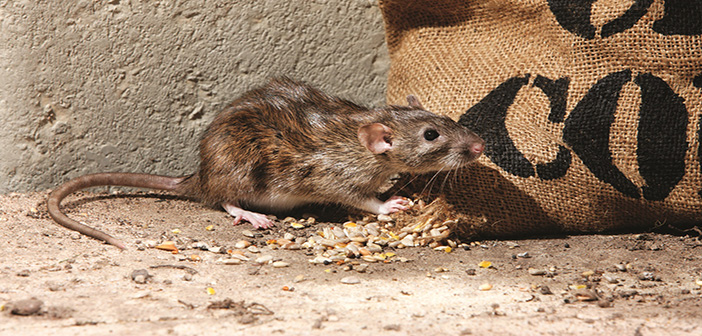Laurence Barnard, from BASF Pest Control Solutions, shares his advice on how pest controllers can help tackle rodents in rural locations and educate farmers on how to monitor the site for signs of further activity.
All pest controllers know that rodents can introduce an array of issues for farmers, with contamination, disease and damage to property being the top causes of financial losses. In fact, it is estimated that one rat can consume and contaminate 100kg of stored animal feed and grain per year, meaning a severe infestation of 200+ rats can potentially ruin a massive 200 tonnes annually.
Rodents can introduce a variety of diseases to livestock, which ultimately can lead to a decrease in output, such as milk production in cows, or even in extreme circumstances, severe illness, or death, creating a further dent in farm profits and costs.
Understandably, farmers and farm managers don’t have the same level of expertise as professional pest controllers, so it’s important trained pest professionals give top tips to their rural clients to ensure rodent activity doesn’t pick back up after treatment has been completed.
When an infestation is identified, it’s easy to reach straight for a chemical solution to try and deal with the issue, but this is not a sustainable long-term fix. In most cases you may never completely rid a farm of rodents for sustained periods of time. But before any chemical pest control solution is considered, an effective environmental management and proofing programme thorough integrated pest management programme (IPM) must be conducted.”
What is an integrated pest management plan?
An integrated pest management (IPM) plan is a strategy to prevent, detect and control pests. It is an approach to pest control that focusses on reducing the reliance on chemicals, and instead looks at ways to prevent infestations from occurring in the first place, putting factors in place to detect them before they get out of hand. Not only does this help protect farmers’ livestock and livelihoods, but it also reduces the negative impact on the environment through limiting the need to introduce toxic substances.
An IPM approach does not only protect against rodents, but also the introduction of other problematic pests too. It is a strategy that should be followed throughout the year to safeguard the farm, its animals, and workers. Here are my top tips and preventative measures that pest controllers can use to inform and encourage their rural client to implement into their IPM for ongoing protection.
Maintain a clean and tidy site
While it may seem straightforward, regularly tidying up the site is the first essential step and should be a consistent part of everyday maintenance routine. Pest controllers should encourage farmers to eliminate access to potential food sources, as well as advise them to minimise the use of pallets and sacks, as these provide ideal shelter for rodents. Additionally, they should dispose of any rubbish or unwanted straw and hay to reduce the time available for rodents to settle in.
Fully appreciate this is all easy said than done, and it can be very difficult to get your farmer to comply with these requests, but it has been proven time and time again, that a farm that is free of clutter and well maintained will experience considerably less issues than one that isn’t.
Cut back vegetation and bushes around buildings
As pest controllers know, rats tend to avoid open spaces, so by encouraging farmers to cut back shrubs and vegetation by at least one meter around all buildings as this will make them less likely to cross an open yard to enter. This also makes it easier for professionals to see any rat burrows and gives predators such as cats or birds of prey more chance of spotting them too.
Rodent-proof buildings
Rodents can squeeze through surprisingly small openings — mice can pass through gaps as small as 6 mm, and rats can get through gaps of 10 mm. Therefore, pest controllers should thoroughly inspect all buildings, storage areas, and outhouses for any wear and tear in walls, pipes, doors, and windows. If possible, use durable materials to block any compromised areas, as it’s well known that rats can chew through everything from wooden posts to drywall.
Examine the building for evidence of an existing infestation
By teaching farmers to look for visible signs between visits such as footprints at ground level or on ledges, smear marks along ledges, walls, or cables, structural and equipment damage from gnawing, and droppings, farmers have a quicker chance to inform you about the infestation before it gets out of hand, especially if you are only onsite every four weeks.
It’s important to check all electrical wires and cables, as many farm fires have been caused by rodents chewing through them.
Where a site has been free of rodents for a period, switching to monitoring products like BASF’s Monitoring Paste is a great way to detect early signs of infestation, and if activity is confirmed, switching to its sister bait, Selontra, will be smoother due to the neophobic behaviour towards the fresh bait being reduced thanks to its same high-palatability formula.
Securely store animal feed
Protecting animal feed from contamination and consumption is a crucial step. Rats can carry up to 45 dangerous diseases, posing significant health and safety risks. Make sure storage areas are thoroughly cleaned and inspect them closely for any entry points or damage where rodents could get in.
Pest controllers should also advise farmers to clean up any food spills immediately. Again, much easier said that done and in many cases the farmer will ignore you but be but sure to document any recommendations as evidence/reference points for further down the line when an issue occurs.
Despite best efforts, preventative measures can fail due to the attractiveness of farms to pests. If an infestation is suspected, farmers should call their pest control service provider immediately. Signs of confirmed activity could already signify a severe infestation is underway, so pest controllers must act fast to ensure control is regained.
If all preventive and non-chemical control methods fail and farmers alert you to the signs of reinfestation, it’s crucial for pest controllers to choose the right control method for the situation and act with best practice in mind. In some cases where the issue is minor, it maybe that traps are an appropriate solution to get on top of the issue. However, a lot of time the inflow of rodents can outpace your ability to keep the numbers down by trapping alone, and therefore choosing the rodenticide might be the best course of action.
Due to the risk to non-target species, treating rural locations can be a challenge. And with the increase in rodenticide resistance, many anticoagulants are not suitable. Instead, pest controllers should consider using a bait made with cholecalciferol as the active ingredient, such as Selontra as the product is non-persistent and bio-accumulative in the environment, as well as being the only product on the market with Field/Wood mice (Apodemus sylvaticus) on the label.
Selontra also has no known resistance and can achieve control in as few as seven days. Its stop-feed effect halts both rats and mice within 24 hours of consuming a lethal dose, eventually leading to death through hypercalcemia – excessive calcium in the blood.


